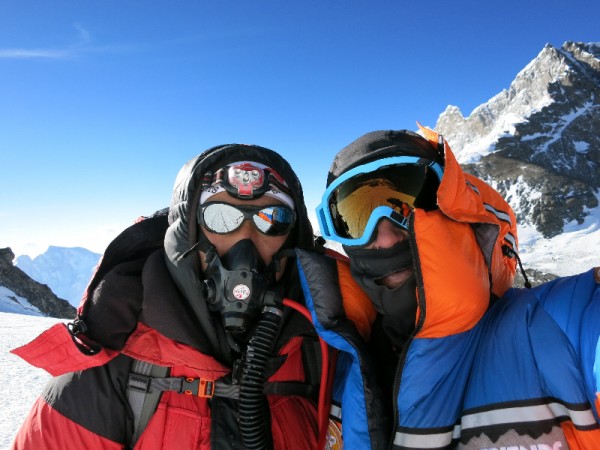5 Tips From Chad Kellogg’s Everest Speed Training

Getting Sick at Altitude? 5 Tips From Chad Kellogg’s Everest Speed Training
Chad Kellogg has trained for more than six years to become the fastest climber on Everest. The lessons he learned on previous Everest attempts and speed climbs of other mountains have given him a strong understanding of what it takes to succeed at altitude. Here are the key techniques Chad uses to prepare for Everest:
1. Train your heart, legs and lungs in advance.
Chad’s Everest program focuses primarily on volume and endurance training. Both types of training also condition his legs for climbing. Most of the locations and resources he uses are free and available to anyone, anywhere. You can easily scale Chad’s workouts to fit your available resources and goals.
Chad’s volume training involves high-intensity sets of stair intervals. In a typical session he’ll make twelve to fifteen fast-paced laps on a steep staircase composed of 388 steps. These workouts are relatively short, but have a big impact on his ability to process oxygen efficiently. They also promote recovery, as the return trip to the bottom of the stairs acts as a rest period between efforts.
Endurance comes in the form of trail running. Chad runs regularly, putting in eight to twelve miles a day, usually four days per week. Occasionally he pushes these runs to ultramarathon distances. Establishing and maintaining a pace is critical to these training sessions.
In order to balance his training and maintain core strength, Chad supplements these workouts with lightweight, high-rep weight training. The result is a fitness set customized for gaining elevation fast, or as Chad says, “the physical solution to the problem the mountain presents.”
2. Focus on hydration and increase your intake of fluids.
Dehydration compounds the effects of elevation. Climbers need to take in more fluids than normal to offset their effort and keep the body functioning at altitude.
Chad makes fluid consumption a priority on all his climbs, but especially on Everest. On the mountain all fluids come from melted snow, so Chad uses the Reactor stove system to provide fast, weight-efficient hydration during the climb. The Reactor’s efficient performance on the mountain allows him to carry less weight and take in more fluids. Chad also uses a hydration system to make his fluids available at all times.
3. Eat simple, whole foods.
As you climb higher your digestive system becomes less efficient. Chad counters this by simplifying his diet when he’s on the mountain. He focuses on whole foods and avoids refined and processed foods that are more difficult to digest. He also eats a vegetarian diet, as meat is more challenging to digest at altitude.
On summit day, Chad consumes all his calories in liquid form. This approach maximizes fluid intake and provides an easy-to-digest food source that can be consumed without stopping and removing his gloves.
4. Take the time to acclimate properly.
Chad lives and trains in Seattle, just above sea level. That might sound like a disadvantage, but it has little impact on his climbing. When Chad approaches a climb he takes the time to acclimate fully. This year he began his trip to Everest almost two months before he expects to make his speed ascent. By trekking to base camp he allows ample time to acclimate, while continuing the final phase of his training. On the mountain, Chad continues to acclimate slowly and carefully. This is the approach he uses:
“The routine I use is to climb up a maximum of 3,000 ft and carry a load or take a hike to acquaint your body to the higher elevation, then return to camp and sleep well. Then move up to your next high point on the second day. Rest the third day and acclimate to the new height. Repeat the three day formula, averaging 1,000 ft per day.”
This approach is easily applied to any mountain that requires establishing camps and making significant efforts at high elevations.
5. Go slowly and take your time.
This might seem like surprising advice from a speed climber, but it makes sense over the course of a long climb. When time allows, Chad slows his pace and allows his body to recover. This technique puts the recovery portion of his interval training to work. It also allows him to focus on safety and mental clarity as he moves into more challenging terrain.
“When you only need to gain 1-3,000 ft. of elevation you can relax and not push yourself into exhaustion. It takes more time to recover physically at altitude.”
This approach also allows Chad to enjoy the mountain and route fully. For him, even a speed ascent is an opportunity to appreciate the beauty of the mountains.
